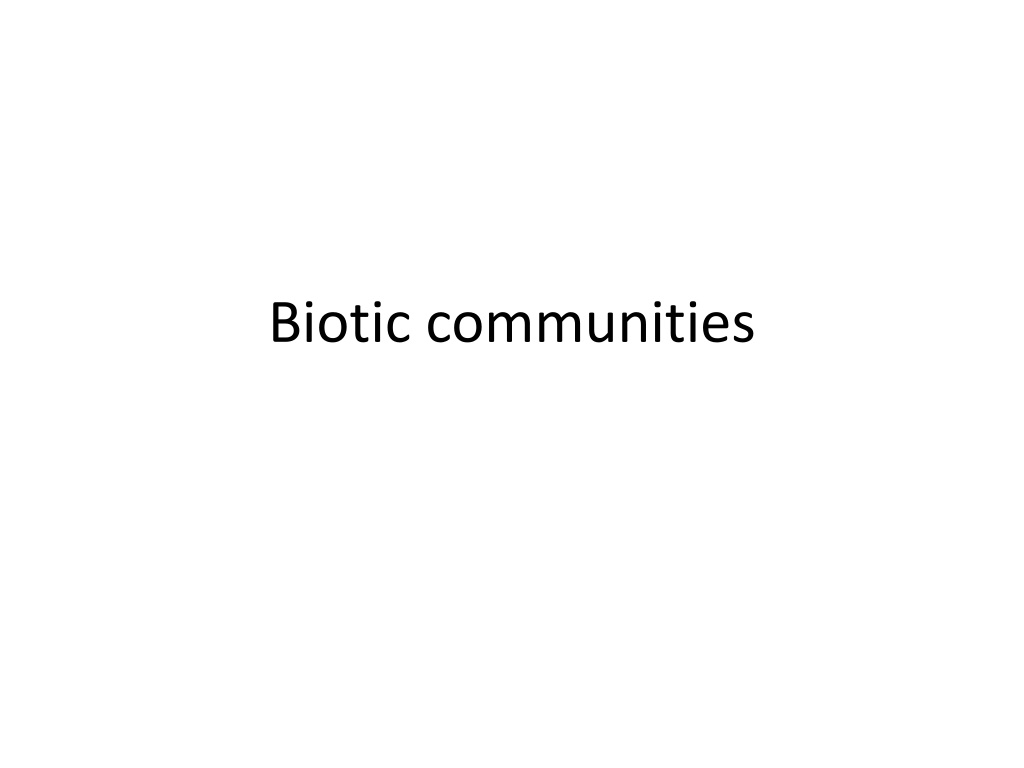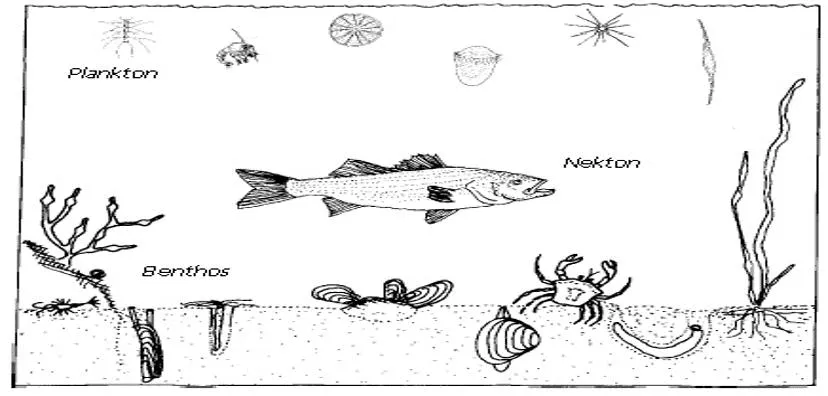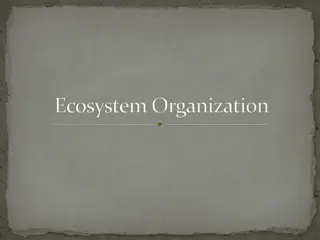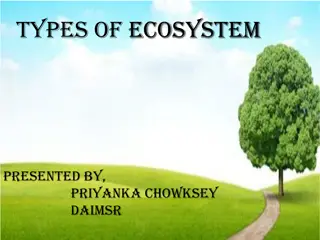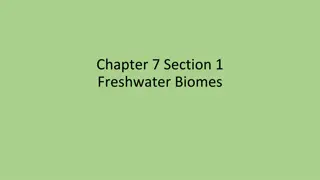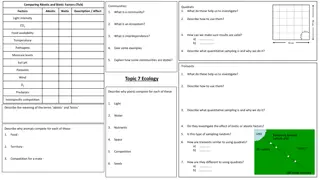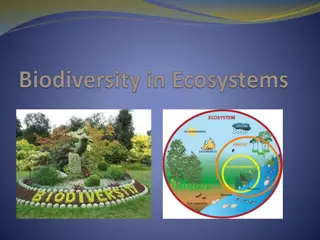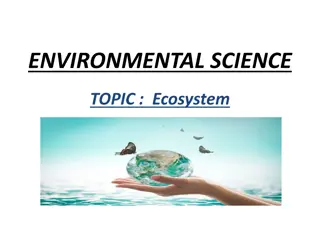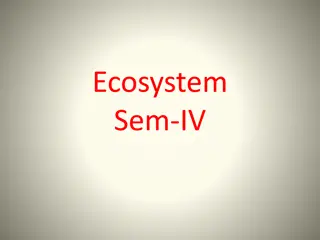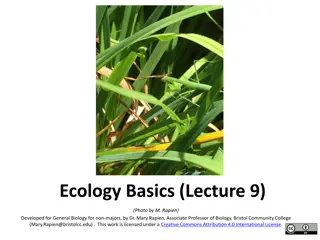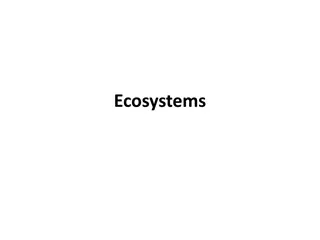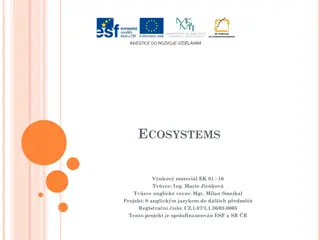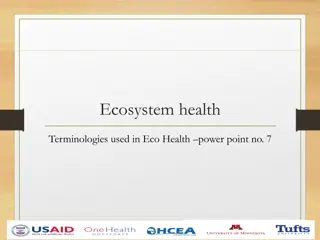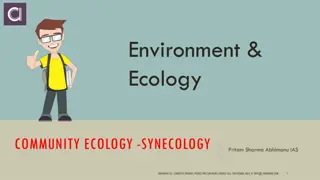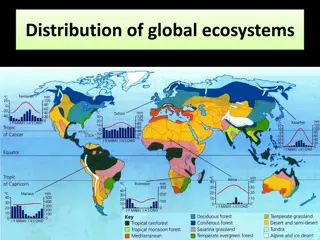Biotic Communities and Benthic Ecosystems
Living organisms in an area form biotic communities categorized into producers, consumers, omnivores, detrivores, and decomposers. Aquatic organisms such as plankton, benthos, and nekton play vital roles. Benthic communities refer to organisms attached to or burrowing in aquatic ecosystems, influenced by factors like water depth and food availability. The classification of benthic organisms includes macrobenthos, meobenthos, and microbenthos.
Download Presentation

Please find below an Image/Link to download the presentation.
The content on the website is provided AS IS for your information and personal use only. It may not be sold, licensed, or shared on other websites without obtaining consent from the author.If you encounter any issues during the download, it is possible that the publisher has removed the file from their server.
You are allowed to download the files provided on this website for personal or commercial use, subject to the condition that they are used lawfully. All files are the property of their respective owners.
The content on the website is provided AS IS for your information and personal use only. It may not be sold, licensed, or shared on other websites without obtaining consent from the author.
E N D
Presentation Transcript
The living organisms in a certain area form the biotic community Three types of living organisms inhabit a biotic community Producers (or autotrophs) - plants and bacteria convert energy into food Consumers (or heterotrophs) - eat plants and animals to survive The consumers include herbivores (primary consumers), which eat only plants; Carnivores (secondary consumers) - eat other animals
Omnivores - eat both plants and animals Detrivores -eat plants and animals that are already dead Examples: some fishes crabs, vultures, and termites Decomposers - change plants that have died into nutrients that allow them to survive
Aquatic organisms are the referred to as biological components of an ecosystem They can grouped according to the conditions of their existence Plankton Benthos Nekton Bacteria Fungi
BENTHIC COMMUNITIES Those animals and plants that are attached to, crawl over, or that burrow into the bottom in aquatic ecosystems Are always associated with benthic floor from litter zone to the deep sea system They live in the marine sediments distributing from tidal pools along the foreshore to the abyssal depths The term benthos comes from the Greek word meaning depths of the sea Benthos also lives in freshwater bodies of water, such as lakes, rivers and streams.
The distribution occurrence and structure of most benthic organisms are determined by depth of water, temperature dissolved oxygen, salinity soil texture, availability of food and their biological interactions Filter feeders, such as sponges and bivalves dominate the hard sandy bottoms Deposit feeders such as polychaetes populate in softer bottoms Fish, sea stars, snails, cephalopods, and crustaceans are important predators and scavengers
CLASSIFICATION OF BENTHIC ORGANISMS Macrobenthos- (>500um) Meobenthos - (60 and 500um) Microbenthos - (<60um)
Macrobenthos Macrobenthos are the larger, more visible, size greater than 0.5 mm in size Examples: polychaete worms, bivalves, echinoderms, sea anaemones, corals, sponges, sea squirts, turbellarians and larger crustaceans such as prawns, crabs, lobsters, mysids, krill, isopods, cumaceans etc http://upload.wikimedia.org/wikipedia/commons/thumb/e/e9/Nerr0878.jpg/120px-Nerr0878.jpg http://upload.wikimedia.org/wikipedia/commons/thumb/d/d5/Benthic_GLERL_1.jpg/120px-Benthic_GLERL_1.jpg
Important macro benthoic population Echinoderms Star fish, sea urchin, brittle star, sealillies, sea cucumbers Plants Sargasssum, Ulva, Gracillaria, Hippnia, Codium Sponges Sycon, Grantia Coelenterate Sea anemones, Sertularia Annelids Nereis, Eunice, Sabellaria Arthropods Hermit crabs, Mysids, Gammarus, Isopods, Cumecians Molluscs Mytilus, Littorina, Patella, Murex, Teredo, Cyprea, Crossostrea, Ostrea Prochordata - Ascidia, Botrythus Fishes - Demersal fishes ; soles, sharks, skates
Meiobenthos Tiny benthic organisms size less than 0.5 mm but greater than 60 m They are naked, present in large numbers Important meiobenthos are Protozoans Radiolarians, ciliates ; Coelenterates Hydrozoa obelia ;Annelids Neries ; Tarligrada ; Rotifera ;Gastrotricha ; Nematode ; Archiannelide; Copepods ; Ostrocods; Mystacocarida etc. http://upload.wikimedia.org/wikipedia/commons/thumb/0/06/Live_Ammonia_tepida.jpg/120px-Live_Ammonia_tepida.jpg http://upload.wikimedia.org/wikipedia/commons/thumb/6/6d/Gastrotrich.jpg/115px-Gastrotrich.jpg http://upload.wikimedia.org/wikipedia/commons/thumb/2/28/Copepodkils.jpg/120px-Copepodkils.jpg Foraminifera Gastrotrich Copepod
Microbenthos They are microscopic benthos that are less than 32 m in size and contributing in benthic productivity Ex:bacteria, diatoms, ciliates, flagellates etc. http://upload.wikimedia.org/wikipedia/commons/thumb/3/31/Diatoms_through_the_microscope.jpg/120px-Diatoms_through_the_microscope.jpg http://upload.wikimedia.org/wikipedia/commons/thumb/5/5a/Stentor_roeseli_composite_image.jpg/120px-Stentor_roeseli_composite_image.jpg http://upload.wikimedia.org/wikipedia/commons/thumb/c/c0/Giardia_lamblia.jpg/120px-Giardia_lamblia.jpg Marine diatoms Ciliates flagellate
Important microbenthos are Ciliates Bacteria Fungi Larval forms
NEKTON COMMUNITIES Nekton - capacity to move around in the water purposively and independently Active swimming animals, provided with efficient locomotive organs such as lateral fins, caudal fins and stream lined body. Eg. Fishes, cephalopods, mammals etc. Three living classes of fish: The primitive jawless fishes (Agnatha); Shark like fishes (Cartilaginous or Chondrichthyes) The bony fishes (Osteichthyes).
PLANKTON COMMUNITIES Plankton and neuston - consists of free floating organisms, both animals and plants whose movements are so feeble that they remain essentially at the mercy of current or other water movement All Plankton are members of the euplankton (True plankton) as against the pseudoplankton (Nonliving debris or dead plankton)
FUNCTIONAL GROUPS OF PLANKTON There are two types of plankton - phytoplankton and zooplankton The word phyto comes from the greek word meaning 'plant' and plankton translates to 'drifter These tiny organisms are plants that drift throughout the world s oceans Six relatively large, variously-shaped organisms with dozens of small light-colored dots all against a dark background. Some of the organisms have antennae that are longer than their bodies. Planktonic organisms
Phytoplankton (phyton, or plant), autotrophic, prokaryotic or eukaryotic algae that live near the water surface where there is sufficient light to support photosynthesis Ex: diatoms, cyanobacteria, dinoflagellates silicoflagillates, green algae, blue green algae etc and coccolithophores, Zooplankton (zoon or animal), small protozoans or metazoans(e.g. crustaceans and other animals ) that feed on other plankton and telonema Ex: eggs and larvae of larger animals, such as fish, crustaceans, and annelids Bacterioplankton, bacteria and archaea, which play an important role in remineralising organic material down the water column (note that the prokaryotic phytoplankton are also bacterioplankton)
